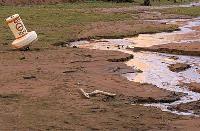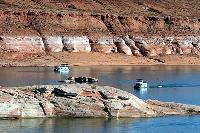BEAR RIVER CITY - Charles Holmgren says it's the little things that he notices.
The Box Elder County farmer, who grows a variety of crops on 1,200 acres near here, has seen the spring runoff come down the Corrine Canal from the Bear River flows sooner than it used to. After nearly a lifetime of getting three cuts a season out of his alfalfa crop, Holmgren notes that he's now regularly getting four. And he and fellow members of the irrigation company that feeds the area's farms are paying out more in attorneys fees than they ever have before to settle water rights disputes.
Holmgren can't specifically point to climate change as the culprit; it's all anecdotal at this point. But he does sense that things are different now. And he can't help but wonder what lies ahead.
"It's a two-edged sword," he says. "If you have livestock, you like the warmer, drier winters. But when crop time comes around in June and July, you really need that water. It doesn't help when it comes down in February or March. Once it goes down the river, it's gone."
More than any other aspect of global warming, water will likely be what defines the issue in Utah and the rest of the Intermountain West in the coming decades. The nation's most arid and sparsely populated region has been transformed by explosive growth and development in recent decades, growth that has been based largely on an ability to manage
Advertisement
But those resources are increasingly under strain as such cities as Las Vegas, Phoenix and, closer to home, St. George, continue to expand at unprecedented rates. A long-term drought, one the region may still be in the grips of, got the attention of federal and state water managers earlier this decade. Now climate change - the prospect of rising temperatures, less snowmelt and, perhaps, less precipitation - is prompting further
|
"The message I can give is that we are paying attention to it," says Mark Limbaugh, assistant secretary for the Interior Department. "But to say we have a clear path towards a solution, I don't think we're there yet."
The variables of water: Though there is now a general scientific consensus about global warming - it's real, it's occurring right now and we are at least partially responsible for it - there is much less unanimity about the impacts climate change will have on precipitation and water supplies in the interior West. In fact, the research is all over the place.
Different climate models produced in recent years have spit out a variety of conclusions. Some predict close to normal precipitation, but more of it falling as rain and less as snow, with the rainfall coming at different times of the year. Other models call for more precipitation, which could actually bring some positive effects - anybody up for the Great Basin grasslands? And still others forecast less precipitation, which would be the worst scenario of all. But for the time being, uncertainty is the rule.
"It's demonstrable that global warming is happening," says Randy Julander, state snow surveyor for the U.S. Agriculture Department. "Once you get past that, though, you start getting into connectivity issues - things that have happened and are happening right now. How do we separate all the variables to pull out the thread of global warming?
This is especially pertinent when it comes to water, Julander adds, because such variables as weather modification (e.g., cloud seeding), vegetation changes (such as the decrease in aspen trees and the rise of conifers across the Rockies) and such events as wildfires all impact the high elevation snowpack.
Across the vast Colorado River Basin, 85 percent of the water consumed by municipal and agricultural users comes from snowmelt.
That said, there is enough data out there now to begin sizing up possible global warming and water scenarios for Utah and the Intermountain region.
|
A 2003 study by Frederic Wagner, a professor emeritus of the Department of Forest, Range and Wildlife Science at Utah State University, lays out a variety of possibilities if temperatures increase from nearly 4 to 6 degrees Fahrenheit by 2100.
l Increased precipitation: This scenario could accommodate a doubling of the region's current population over the century, continue to provide for agricultural uses, and could actually see an increase in the water supply. Water management changes, however, would be necessary to address decreased snowpack and heightened flood possibilities.
l Same precipitation: Social and economic impacts would be roughly the same as above for the northwestern part of the region, which would still enjoy some extra precipitation. But a temperature increase and no change in precipitation in the southeastern portion of the area would exacerbate the current water scarcity and reduce water resources.
l Decreased precipitation: Would lead to desertification of the region and a decline in water resources, likely leading to water transfers from agriculture to urban areas. That would in turn lead to a steep decline of farming and ranching and deal the outdoor recreation industry, particularly skiing, a serious blow.
If that worst-case scenario plays out, says Dennis Strong, director of the Utah Division of Water Resources, some fundamental cosmetic surgery will be necessary.
"It would come down to changing the way Utah looks," he says. "Nobody wants to see the grass or the trees go away. But what we're talking about is what we really need."
More, bigger reservoirs? But just about any climate change scenario in Utah that leads to reduced snowpack will likely require some rethinking about our systems for capturing water. And that could mean bracing for a new round of costs and impacts of new dams, pipelines and other structures, according to a USU researcher.
Jack Schmidt, an aquatic, watershed and earth resources professor who specializes in Colorado River issues, predicts the biggest factor in terms of warming temperatures will be the timing of the snowmelt and the amount of variability between rain and snow.
"That doesn't mean we're cooked. But it may mean a new wave of dam and reservoir projects and that may mean some environmental reversals," he says. "We're in an era now that is focused on the environmental protection of our rivers. But that may be for naught if we have to build 10 new reservoirs to capture more snowmelt or more water from other sources."
Those are the kinds of issues water managers ought to be addressing right now, but aren't, according to environmental and other critics.
"It's worth pointing out that there are 400 water districts in Utah, a complex set of state water laws and the Law of the [Colorado] River. And the primary objective of all these districts and statutes is to protect the status quo," says Dan McCool, a University of Utah political science professor who specializes in water issues. "But the status quo doesn't exist any longer. It is a system that is hopelessly out of sync with the demographic reality, the economic reality and the meteorological reality."
But water officials maintain they have no choice but to tread water - pardon the expression - for the time being.
"Which science do you depend on?" says Ron Thompson, manager of the Washington County Water Conservancy District. "I have heard no consensus on what the impact of climate change will be on the southwestern United States.
Battle lines drawn: One thing is for sure, though. The politics of water, already rough, are going to get even rougher. Especially if the resources are more scarce and states wind up pitted against each other. The Colorado River Compact tying together the seven basin states - Utah, Wyoming, Colorado, New Mexico, Nevada, Arizona and California - has been in existence since 1922. It may not make it through the next century.
Says USU professor Schmidt: "Utah has nodes of dense population with tentacles of supply lines that bring water and electricity. If water gets scarce, what happens to the nerve center - the Wasatch Front - and those supply lines? Utah will be competing against other people for the same thing. And in that context, how do we compete against states like Arizona and California that are economic powerhouses?"
A sneak preview may be going on right now on the Utah-Nevada border, where the Southern Nevada Water Authority is planning to take groundwater out of aquifers under the state line and pipe it to Las Vegas - an action the district has been forced to take because it has essentially exhausted its allotment of Colorado River water. Ranchers and environmentalists on both sides of the line are fighting the Southern Nevada plan and threats have been issued both at the state and congressional levels.
However, Colorado River water managers believe they have gotten an early handle on the climate change issue with a drought management agreement that was negotiated by the seven basin states earlier this year. Though not global warming-specific, they maintain it represents a head start.
But Richard Ingebretson, founder of the Glen Canyon Institute, says it probably won't make much difference in the long run.
"Global warming is happening now. And it is so horribly affecting the Colorado River that they're going to have to renegotiate the whole [Colorado Compact]," he says. "The drought management agreement is just a prelude to many, many changes.
jbaird@sltrib.com




